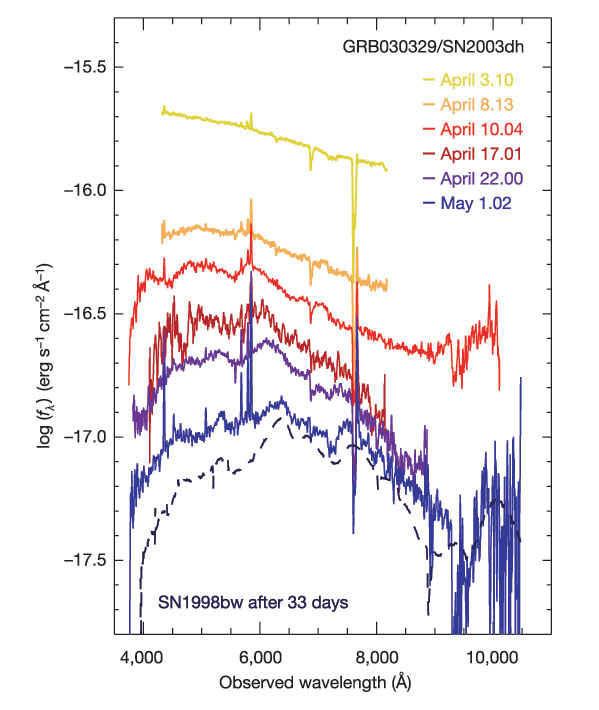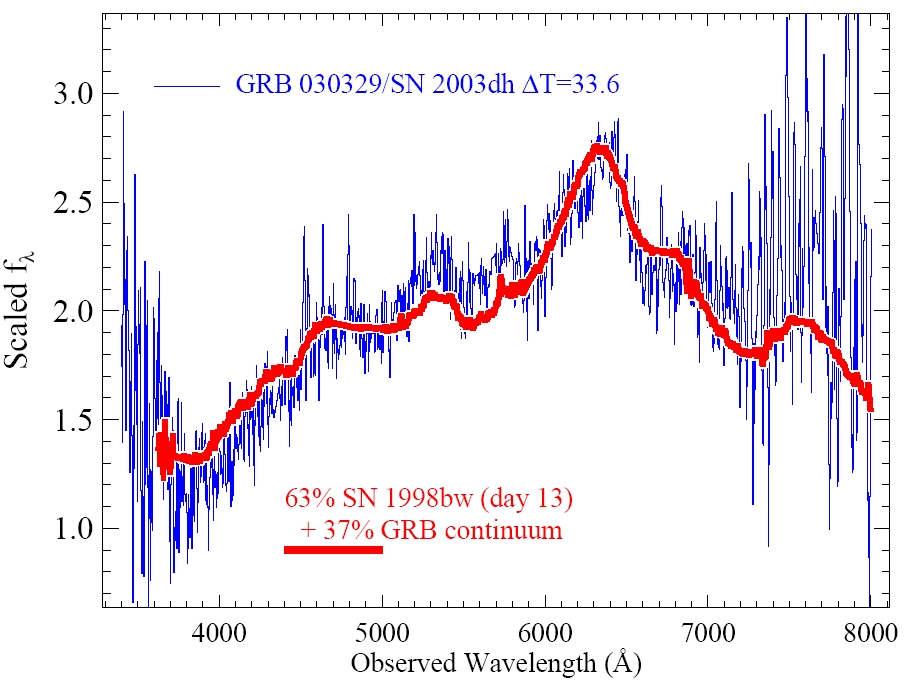
2. ELECTROMAGNETIC OBSERVATIONS
2.4 MULTI-WAVELENGTH AFTERGLOWS
2.4.5 THE COLLAPSAR PROGENITOR MODEL: THE GRB030329/SN2003dh CONNECTION
It should be noted that the fireball description is really a phenomenology. In fact, the formalism is viability even in the absence of an identified progenitor(s). Our ignorance of the progenitor event is a consequence of a physical limitation due to the initial optical thickness of the fireball (prior to relativistic adiabatic expansion). Hence, we cannot "see" the progenitor event. In fireball framework, we utilizes a phenomenological approach based upon observables gleaned from the prompt gamma and multi-wavelength afterglow emissions (e.g. fluence, redshift, etc.) in order to constrain the burst energetics and microphysics of the burst in addition to making make predictions.
The
cosmological distance scales of GRBs, coupled with their measured flux and rapid
variability time (~ 10 ms), implies the release of energies ~1 solar mass in
compact regions with linear scale ≤
~10 E8 cm. The two main progenitor models include the merger of binary
compact objects (Janka
et al 1999), such as NS/NS and NS/BH, and the death of massive stars (e.g.
Wolf-Rayet), such as collapsars (Woosley
& Zhang 2003). Ultimately, both progenitor models culminate in the birth of
a black hole (Woosley
et al. 2002). The association between GRBs and supernovae has been recently
confirmed via the connection between GRB030329 and (Type Ic) SN2003dh (Stanek
et al. 2003,
Mazzali et al. 2003), supporting the collapsar progenitor scenario for long
duration GRBs. The spectral evolution of the optical afterglow emission of
GRB030329 is illustrated in figure 2.4.5.1. Based upon spectral analysis, the
host (dwarf) galaxy of GRB030329 has been classified as an active star-forming
region with low metallicity. In this manner, GRBs may serve as cosmological
laboratories for the study of Type Ic supernovae (Lamb
et al. 2003) and help to probe star-forming regions (Bloom
et al. 2001).

FIGURE 2.4.5.1: The combined optical flux density (fl) of the optical transient afterglow of GRB030329/SN2003dh as a function of observed wavelength for various epochs (illustrated by multi-colored spectra). Although the initial spectrum (e.g. yellow spectrum) is well described by a power law, clear spectral evolution converges to a supernova signatures. As a source of comparison, the spectrum of SN1998bw (after 33 days and adjusted for redshift) is shown as the dashed spectrum (Hjorth et al. 2003).
Figure 2.4.5.2 illustrates the comparison between the optical transient
afterglow of GRB030329/SN2003dh and a model based upon the sum of power-law
continuum and a Type Ic supernova (Matheson
et al. 2003). The normalization of the model has been scaled to match the
flux of the observed optical transient spectra. The fraction of the continuum
and supernova components were treated as free parameters and yielded SN1998bw as
the best match based upon the spectral evolution. In this manner, GRB030329 is
understood as the precursor event to SN2003dh.

FIGURE 2.4.5.2: Comparison between the combined optical flux
density (fl) of the optical
transient afterglow of GRB030329/SN2003dh (thin blue line) and a model based
upon the sum of power-law continuum and SN1998bw (thick red line) as a
function of observed wavelength (Matheson
et al. 2003). The fraction of the continuum and supernova components
were treated as free parameters and yielded SN1998bw as the best match based
upon the observed spectral evolution. In the figure above, 33.6 days have
elapsed since GRB030329. The normalization of the model has been scaled to match
the flux of the observed optical transient spectra. The model fit parameters
correspond to a 63% SN1998bw (at day 13) and 37% GRB continuum mixture. Hence
GRB030329 occurred at the same time as SN2003dh.
Spectroscopic observations of the prompt and afterglow emissions of GRB030329 are completely consistent with predictions based upon fireball phenomenology. This connection between long GRBs and supernovae is further strengthened by the observation that the GRB formation rate is strongly correlated to the star formation rate, based upon both observed spectroscopic and best estimated redshift distributions. Hence we have a very important case here where the collapsar scenario, coupled with fireball phenomenology, has been dramatically confirmed via observation. Clearly, the synergy between fireball phenomenology and the collapsar scenario satisfy the requirements of a model and a very successful one at that. Are there still open questions? Of course, no one is claiming that we have all the answers. However, many believe that the most complete version of reality to date is offered by the fireball model. The caveat is that the fireball model does not apply exactly the same in all classes (triggered, non-triggered, etc.) of GRBs. Hence one must make sure that the fireball description applies to a burst of a class of bursts before one tries to apply the model, e.g. spectral analysis of prompt photon emission. For example, a clear problem arises when one tries to apply the fireball formulation with the so called non-triggered bursts since the inferred fluence render the sources optically thick, i.e. thermal spectra, contrary to the synchrotron spectra observed in triggered bursts.